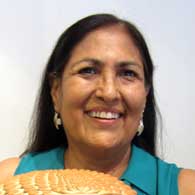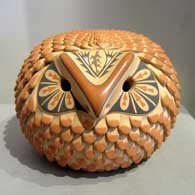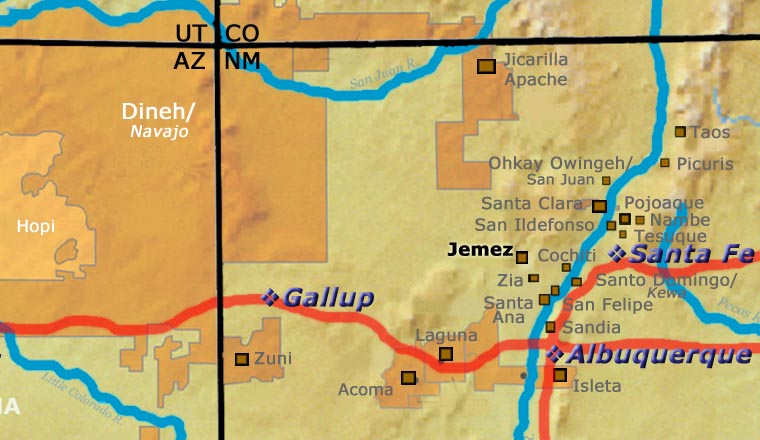
Laura Gachupin
Jemez

Laura Gachupin was born into Jemez Pueblo in November, 1954. As she was growing up her grandmother, Persingula Gachupin, taught her how to prepare the clay. Then her mother, Marie Gachupin Romero, taught her how to make pottery. Laura also took some pottery classes from Ralph Partington at the Institute of American Indian Arts in Santa Fe. In 1974 she dedicated herself to being a full-time traditional Jemez potter. She tells us it was her sister, Maxine Toya, who inspired her to make the figures she is now most known for.
Over the last 40 years Laura has participated in shows and exhibits from coast to coast, but she does try to get to the Heard Museum Guild Indian Art Fair and the Santa Fe Indian Market every year. She's earned a lot of awards for her work, including two Best of Division ribbons at the prestigious Santa Fe Indian Market.
Laura tells us her favorite shapes to make are owls, turtle bowls, melons and other figural pots. She says her ideas just come to her but she also gets inspiration from other artists. There are many designs she still wants to make, especially since she's gotten really interested in birds and bird books.
In Laura's words: "I am so grateful for my life and family and my gift of talent to be a potter. Thankful to have my mom and grandma. I also like to dance with my young grandson, Luciano."
Some Awards earned by Laura
- 2020 Heard Museum Guild Indian Fair & Market, Classification II - Pottery, Division E - Any design or form with native materials, kiln-fired pottery: Second Place. Awarded for the artwork: "Morning Prayer"
- 2013 Heard Museum Guild Indian Fair & Market, Classification II - Pottery, Division D - Traditional, Native Clay, Hand Built, Figurative: Second Place
- 2013 Heard Museum Guild Indian Fair & Market: Judge's Choice Award - Kevin Coochwytewa. Awarded for artwork: "Great Grandpa and Great Grandma Pot"
- 2012 Heard Museum Guild Indian Fair & Market, Classification II - Pottery, Division D - Traditional, Native Clay, Figurative: Second Place.
100 West San Francisco Street, Santa Fe, New Mexico 87501
(505) 986-1234 - www.andreafisherpottery.com - All Rights Reserved

Jemez Pueblo

Ruins of San Jose de las Jemez Mission
As the drought in the Four Corners region deepened in the late 1200's, several clans of Towa-speaking people migrated southeastward to the Canyon de San Diego area in the southern Jemez mountains. Other clans of Towa-speaking people migrated southwest and settled in the Jeddito Wash area in northeastern Arizona, below Antelope Mesa and southeast of Hopi First Mesa. The migrations began around 1275 and were mostly complete by 1350.
Archaeologist Jesse Walter Fewkes argues that pot shards found in the vicinity of the ruin at Sikyátki (near the foot of Hopi First Mesa) speak to the strong influence of earlier Towa-speaking potters on what became "Sikyátki Polychrome" pottery (Sikyátki was a village at the foot of First Mesa, destroyed before the first Hopi contact with the Spanish in 1540). Fewkes maintained that Sikyátki Polychrome pottery is the finest ceramic ware ever made in prehistoric North America.
Francisco de Coronado and his men arrived in the Jemez Mountains of Nuevo Mexico in 1539. By then the Jemez people had built several large masonry villages among the canyons and on some high ridges in the area. Their population was estimated at about 30,000 and they were among the largest and most powerful tribes in Northern New Mexico. Some of their pueblos reached five stories high and contained as many as 3,000 rooms.
Because of the nature of the landscape they inhabited, farming was very hard. So the Jemez became traders, too, and their people traded goods all over the Southwest and northern Mexico.
The arrival of the Spanish was disastrous for the Jemez and they resisted the Spanish with all their might. That led to many atrocities against the tribe until they rose up in the Pueblo Revolt of 1680 and evicted the Spanish from northern New Mexico. With the Spanish gone, the Jemez destroyed much of what they had built on Jemez land. Then they concentrated on preparing themselves for the eventual return of the hated priests and the Spanish military.
The Spanish returned in 1692 and their efforts to retake northern New Mexico bogged down as the Jemez fought them doggedly for four years. In 1696 many Jemez came together, killed a Franciscan missionary and then fled to join their distant relatives in the Jeddito Wash area. They remained at Jeddito Wash for several years before returning to the Jemez Mountains. As a result of that long ago contact, there are still strong ties between the Jemez and their cousins on Navajo territory at Jeddito. On their return to the Jemez Mountains, the people built the pueblo they now live in (Walatowa: The Place) and made peace with the Spanish government.
Some of the Jemez people had been making a type of plainware pottery (simple, undecorated, utilitarian) when they were still in the Four Corners area, while others had developed a distinctive type of black-on-white pottery. In moving to the Jemez Mountains, they brought their knowledge and techniques with them but had to adapt to the different materials available to work with. Over time, the Jemez got better in their agricultural practices and began trading agricultural goods to the people of Zia Pueblo in return for pottery. By the mid-1700's, the Jemez were producing almost no pottery.
East of what is now Santa Fe is where the ruins of Pecos Pueblo are found. Pecos Pueblo was a large pueblo housing up to 2,000 people at its height. The people of Pecos and the Galisteo Basin were the only other speakers of the Towa language in New Mexico and when that area fell on increasingly hard times (Apache and Comanche raids, European diseases, drought), Pecos was finally abandoned in 1838 when the last 17 residents moved to Jemez. The Governor of Jemez welcomed them and allowed them to retain many of their Pecos tribal offices (governorship and all). Members of former Pecos families still return to the site of Pecos Pueblo every year to perform religious ceremonies in honor of their ancestors.
When general American interest in Puebloan pottery started to take off in the 1960's, the people of Jemez sought to recover that lost heritage. Today, the practice of traditional pottery-making is very much alive and well among the Jemez.
The focus of Jemez pottery today has turned to the making of storytellers, an art form that now accounts for more than half of their pottery production. Storytellers are usually grandparent figures with the figures of children attached to their bodies. The grandparents are pictured orally passing tribal songs and histories to their descendants. While this visual representation was first created at Cochiti Pueblo (a site in close geographical proximity to Jemez Pueblo) in the early 1960's by Helen Cordero, it speaks to the relationship between grandparents and grandchildren of every culture.
The pottery vessels made at Jemez Pueblo today are no longer black-on-white. Instead, the potters have adopted many colors, styles and techniques from other pueblos to the point where Jemez potters no longer have one distinct style of their own beyond that which stems naturally from the materials they themselves acquire from their surroundings: it doesn't matter what the shape or design is, the clay says uniquely "Jemez."
100 West San Francisco Street, Santa Fe, New Mexico 87501
(505) 986-1234 - www.andreafisherpottery.com - All Rights Reserved
